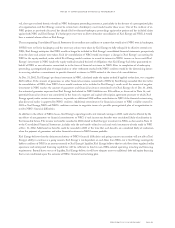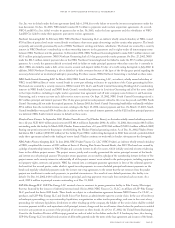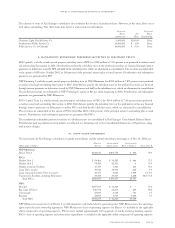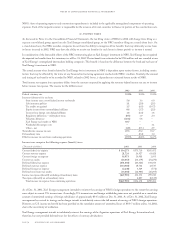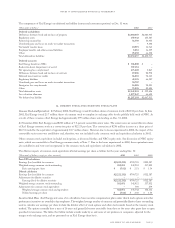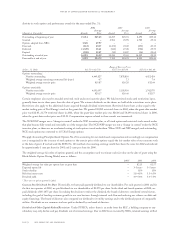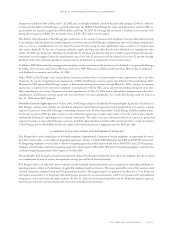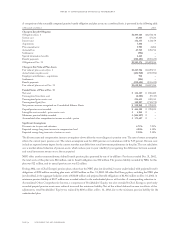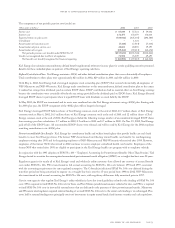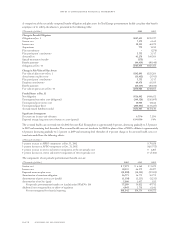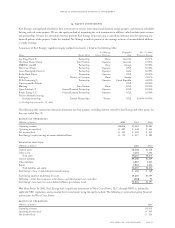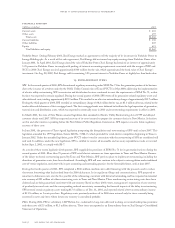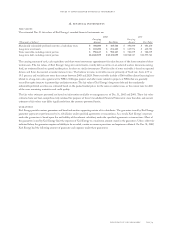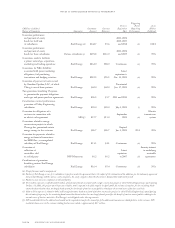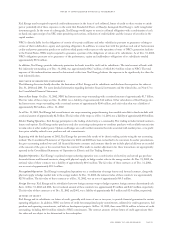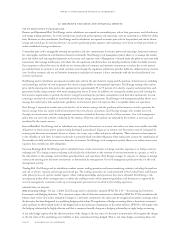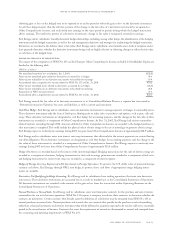Xcel Energy 2002 Annual Report Download - page 59
Download and view the complete annual report
Please find page 59 of the 2002 Xcel Energy annual report below. You can navigate through the pages in the report by either clicking on the pages listed below, or by using the keyword search tool below to find specific information within the annual report.Energy were a deficit of $101 million at Dec. 31, 2002, and, accordingly, dividends cannot be declared until earnings in 2003 are sufficient
to eliminate this deficit or Xcel Energy is granted relief under the PUHCA. Xcel Energy has requested authorization from the SEC to
pay dividends out of paid-in capital up to $260 million until Sept. 30, 2003. Xcel Energy did not declare a dividend on its common stock
during the first quarter of 2003. It is not known when or if the SEC will act on this request.
The Articles of Incorporation of Xcel Energy place restrictions on the amount of common stock dividends it can pay when preferred stock
is outstanding. Under the provisions, dividend payments may be restricted if Xcel Energy’s capitalization ratio (on a holding company basis
only, i.e., not on a consolidated basis) is less than 25 percent. For these purposes, the capitalization ratio is equal to (i) common stock
plus surplus divided by (ii) the sum of common stock plus surplus plus long-term debt. Based on this definition, our capitalization ratio
at Dec. 31, 2002, was 85 percent. Therefore, the restrictions do not place any effective limit on our ability to pay dividends because the
restrictions are only triggered when the capitalization ratio is less than 25 percent or will be reduced to less than 25 percent through
dividends (other than dividends payable in common stock), distributions or acquisitions of our common stock.
In addition, NSP-Minnesota’s first mortgage indenture places certain restrictions on the amount of cash dividends it can pay to Xcel Energy,
the holder of its common stock. Even with these restrictions, NSP-Minnesota could have paid more than $825 million in additional
cash dividends on common stock at Dec. 31, 2002.
Under PUHCA, Xcel Energy is also restricted from financing activities when its common equity to total capitalization ratio is less than
30 percent. As a result of significant asset impairments at NRG, Xcel Energy’s common equity ratio fell below 30 percent during 2002.
However, the SEC approved Xcel Energy’s request to allow certain financing transactions through March 31, 2003, so long as its common
equity ratio, as reported in its most recent quarterly or annual report with the SEC and as adjusted for pending subsequent items that
affect capitalization, was at least 24 percent of its total capitalization. At Dec. 31, 2002, and as adjusted for subsequent items that affect
capitalization, Xcel Energy’s common equity ratio was 23 percent of its total capitalization. As a result, Xcel Energy could not finance at
Dec. 31, 2002, absent SEC approval.
Stockholder Protection Rights Agreement In June 2001, Xcel Energy adopted a Stockholder Protection Rights Agreement. Each share of
Xcel Energy’s common stock includes one shareholder protection right. Under the agreement’s principal provision, if any person or group
acquires 15 percent or more of Xcel Energy’s outstanding common stock, all other shareholders of Xcel Energy would be entitled to buy,
for the exercise price of $95 per right, common stock of Xcel Energy having a market value equal to twice the exercise price, thereby
substantially diluting the acquiring person’s or group’s investment. The rights may cause substantial dilution to a person or group that
acquires 15 percent or more of Xcel Energy’s common stock. The rights should not interfere with a transaction that is in the best interests
of Xcel Energy and its shareholders because the rights can be redeemed prior to a triggering event for $0.01 per right.
13. benefit plans and other postretirement benefits
Xcel Energy offers various benefit plans to its benefit employees. Approximately 51 percent of benefit employees are represented by several
local labor unions under several collective-bargaining agreements. At Dec. 31, 2002, NSP-Minnesota had 2,246 and NSP-Wisconsin had
419 bargaining employees covered under a collective-bargaining agreement, which expires at the end of 2004. PSCo had 2,193 bargaining
employees covered under a collective-bargaining agreement, which expires in May 2003. SPS had 757 bargaining employees covered under
a collective-bargaining agreement, which expires in October 2005.
Pension Benefits Xcel Energy has several noncontributory, defined benefit pension plans that cover almost all employees. Benefits are based
on a combination of years of service, the employee’s average pay and Social Security benefits.
Xcel Energy’s policy is to fully fund into an external trust the actuarially determined pension costs recognized for ratemaking and financial
reporting purposes, subject to the limitations of applicable employee benefit and tax laws. Plan assets principally consist of the common stock
of public companies, corporate bonds and U.S. government securities. The target range for our pension asset allocation is 75 to 80 percent
with equity investments, 5 to 10 percent with fixed income investments, no cash investments and 10 to 15 percent with nontraditional
investments, such as real estate and timber ventures. At Dec. 31, 2002, the actual pension portfolio mix was 68 percent equity, 16 percent
fixed income, 4 percent cash investments and 12 percent nontraditional investments.
notes to consolidated financial statements
xcel energy inc. and subsidiaries page 73


